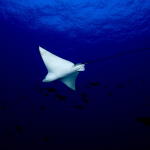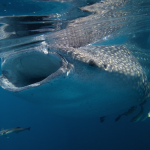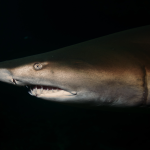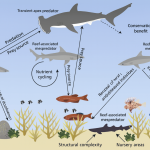A hidden underwater world
The Persian, or Arabian, Gulf is rarely seen as a diving paradise. Most visitors imagine endless heat, oil platforms, and futuristic cities like Dubai or Doha. But beneath the surface lies a living mosaic of warm lagoons, coral gardens, mangrove bays, and sandy flats inhabited by dozens of shark and ray species—from small carpet sharks to majestic eagle rays and massive guitarfishes.
Here, in the heart of the Middle East, Gulf Elasmo Project conducts research, documents rare species, and promotes responsible shark and ray observation. This guide explains where and when to dive, what species to expect, how to behave underwater, and why this region is a unique destination for ocean explorers.
The Gulf: a surprising home for sharks and rays
The Persian Gulf’s warm, shallow waters stay between 22 and 33 °C throughout the year, allowing diving almost anytime. The Gulf averages only about 35 meters deep, which means most encounters with sharks and rays happen in easy recreational ranges. Instead of deep ocean walls, divers explore sandy seabeds and patchy coral reefs that teem with life.
Despite its size, the region supports over sixty shark species and seventy species of rays and chimaeras. Among the most common are the Arabian carpetshark, giant guitarfish, cownose ray, cowtail stingray, and several kinds of eagle rays. Gulf Elasmo Project regularly records their movements, using diver photographs to map population trends and seasonal behavior.
Seasonality – when to see sharks and rays
| Period | Water Temp | Visibility | Activity Level | Notes |
|---|---|---|---|---|
| Nov – Mar | 22–26 °C | up to 20 m | High | Best overall season: comfortable temperature, clear water, active animals. |
| Apr – Jun | 26–32 °C | 10–15 m | Medium | Ray and eagle-ray migrations; active on sandy banks. |
| Jul – Sep | 33 °C + | 5–10 m | Moderate | Very warm water, occasional blooms; nurse sharks and juvenile rays appear. |
| Oct | around 28 °C | 15 m | High | Transition period; larger species return from the outer shelf. |
Winter to early spring (Dec–Mar) offers the best conditions overall, and many Gulf Elasmo Project field surveys take place during this window.
The best months for diving are winter and early spring. From November to March, the water is cooler and clearer, visibility reaches twenty meters, and animal activity is high. During April to June, rays migrate across sandy shelves and eagle rays appear more often. Summer, from July to September, brings very warm water and occasional plankton blooms, but divers sometimes encounter nurse sharks and juvenile stingrays. October is a transitional month with stable weather and the return of larger sharks from the open shelf.
Winter dives usually provide the best combination of comfort, visibility, and marine encounters. This is also when most fieldwork by Gulf Elasmo Project takes place.
The best places for diving
United Arab Emirates
In Abu Dhabi, reefs near Saadiyat and Ras Ghanada host cowtail stingrays, eagle rays, and small reef sharks. Depths are gentle, currents mild, and conditions stable through the winter months.
Fujairah, on the country’s east coast, lies on the edge of the Gulf of Oman but shares species with the Persian Gulf. Divers often see blacktip reef sharks and stingrays near early morning drop-offs.
Dubai offers a different experience with artificial reefs and shipwrecks where Arabian carpetsharks and bamboo sharks rest on sandy decks.
Qatar
Reefs near Al Khor and Fuwairit attract eagle and cownose rays in winter. These areas are shallow, calm, and perfect for beginner divers or snorkelers. The coast near Mesaieed, lined with seagrass meadows, hosts bottom-dwelling sharks and rays. Local projects, including Gulf Elasmo Project, use these sites to monitor population health.
Bahrain
Fasht Al Adhm and Abu Thalma reefs are sandy and full of small coral clusters where whiprays and cowtail stingrays glide gracefully. February to April offers the best conditions with calm seas and good visibility. These waters are ideal for underwater photography and close observation.
Oman
Though outside the narrow Gulf, Oman is vital for migrations that link the Arabian and Persian waters. Musandam is known for dramatic walls and occasional hammerheads or whale sharks, especially from October to May. Around the Daymaniyat Islands, divers encounter eagle rays and leopard sharks in protected, crystal-clear marine reserves.
Saudi Arabia
On the eastern coast, Tarut Bay and Half Moon Bay provide safe, shallow lagoons filled with stingrays and occasional juvenile reef sharks. Diving here is easiest during rising tides when the water clears and currents slow.
How to observe sharks and rays safely
Approach every encounter calmly and keep at least three meters away from large species. Do not block their path or try to force a closer approach for photos. Avoid sudden movements or splashing.
Lighting should be soft and angled away from the animal. In shallow water, strong flashes can disturb rays resting on the sand. Divers are encouraged to use diffused beams and maintain neutral buoyancy to avoid stirring sediment or damaging coral.
Never touch or feed marine life. Avoid using bait to attract sharks. These animals are curious enough on their own, and interaction should never alter their natural behavior.
Diving with purpose: citizen science
Gulf Elasmo Project runs a citizen science program that allows divers and snorkelers to contribute to research. Each sighting photo, even from recreational dives, helps scientists build migration and distribution maps. Participants record the date, location, depth, and observed species, then submit images through the project’s website.
This collaborative approach turns every dive into an opportunity to protect marine life. The collected data already helps identify seasonal nurseries, feeding zones, and migration corridors for sharks and rays across the Gulf.
Essential equipment
Essential gear checklist
| Equipment | Purpose |
|---|---|
| 5 mm wetsuit | Winter temperatures of 22 °C can feel chilly during long dives. |
| Dive torch | Reveals bottom-dwelling species in crevices and mangroves. |
| Wide-angle camera | Ideal for photographing rays that keep their distance. |
| Surface marker buoy (SMB) | Mandatory—boat traffic is heavy. |
| Knife or line cutter | Safety tool in case of fishing-line entanglement. |
Winter dives may require a five-millimeter wetsuit, as temperatures drop to around 22 °C. A good torch helps spot bottom-dwellers in crevices or under ledges. Wide-angle cameras are best for large rays that rarely come close. A surface marker buoy is mandatory because boat traffic can be heavy. Always carry a small knife or line cutter in case of entanglement in fishing gear.
Safety and awareness
Currents can be strong in certain areas, particularly near Musandam. In summer, overheating becomes a real risk, so plan shorter dives and hydrate well. Jellyfish and sea urchins appear seasonally, making a full suit the safest option.
Never dive alone. Avoid direct flash into the eyes of an animal. If a shark shows curiosity, stay calm, maintain visual contact, and move slowly. Most encounters are peaceful and end with the shark gliding away.
The Gulf Elasmo Project promotes an ethical code that centers on minimal impact and maximum awareness. The main principle is simple: take photos, not souvenirs.
Additional locations worth exploring
Abu Dhabi’s mangrove lagoons are known nursery grounds where juvenile rays and small sharks can be seen in shallow water. Bahrain’s sandbanks are excellent for spotting guitarfishes. Around Sir Bani Yas and Dalma Islands, divers occasionally encounter whale sharks during plankton-rich months.
When and where to dive – quick overview
UAE offers excellent diving from November to March, with carpetsharks, stingrays, and eagle rays easy to spot. Qatar’s calm lagoons host cownose rays and guitarfishes in winter, while Bahrain’s sandy reefs provide ideal conditions for underwater photography in early spring. Oman’s season runs from October to May, with possible hammerheads and leopard sharks. On Saudi Arabia’s coast, mild winter months bring numerous stingrays and reef-associated sharks.
Conclusion
The Persian Gulf is far more than a warm, shallow sea beside modern cities. It is a living ecosystem full of motion, color, and ancient life. Beneath its surface swim the quiet architects of marine balance—sharks and rays—vital to the region’s biodiversity.
Diving here is unlike anywhere else. There are no crowds, no chaos, only silence, sand, and the slow rhythm of rays gliding across the seabed. For Gulf Elasmo Project, every diver is not just a visitor but a potential contributor to science and conservation. Every image, every observation, adds a small but important piece to the story of this fragile ocean world.
So pack your camera, charge your torch, and head beneath the calm waters of the Gulf. Sharks and rays have been here for millions of years—they’re waiting for mindful, respectful visitors to witness their grace.
Useful Links:
How to Participate in Gulf Elasmo Project Research
Rare Sharks and Rays of the Arabian
Why Sharks Matter for the Arabian Sea Ecosystem
A Human’s Guide to Sharks of the Arabian Gulf






